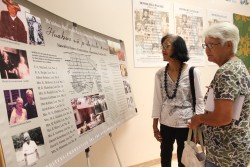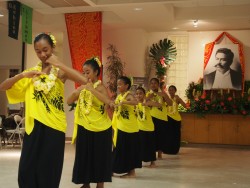Homesteaders Remember their Roots

Community members viewed the names of the original homesteading families on display at the celebration. Photo by Colleen Uechi.
When homesteaders first took up residence on Molokai lands, they had to start from the ground up. Families worked hard together to put in roads and set up large wooden tanks to catch the rainwater for drinking and farming. They combined labor and resources to sow crops and purchase farming equipment.
Ninety years later, Ho`olehua’s fertile lands are inhabited by their thriving descendants, who own homes, grow crops and use the infrastructure put in place by their ancestors.
Last week, the Ho`olehua Homestead Association remembered its history at the homestead’s 90th anniversary celebration. For three days at the Lanikeha Community Center, hundreds of homesteaders gathered to share generations of stories and snapshots of the first families who got the chance to restore both the land and their people. The event also included hula and music, honoring descendants’ families and a pa`ina to wrap up the weekend.
Returning to the Land
Prince Jonah Kuhio, whose portrait sat draped in lei in the center of the celebration hall, was the man whose passion for the `aina and his people brought about Hawaii’s first homesteads on Molokai.
Kuhio, who served as a delegate to Congress, advocated strongly for the rehabilitation of the Hawaiian people. He helped pass the Hawaiian Homes Commission Act in 1921, which awarded land to Native Hawaiians of at least 50 percent blood.
“[His success was due to] his commitment to his vision of returning the Hawaiian people to the land,” said Halealoha Ayau, Molokai Acting District Supervisor for the Department of Hawaiian Home Lands (DHHL). “He had history on his side because the U.S. overthrew [Hawaii] and part of what Congress needed to do was reconcile the fact.”
The first homestead was established in Kalamaula and was “treated like a great experiment” to see whether the program would work, said Ayau. Residents faced the pressure of succeeding in a dry land of salty soil, poor conditions for growing crops. However, they responded well.
In a 1924 Congressional report, observer F.G. Krauss noted that the Kalamaula residents had built homes, were raising many pigs and growing tomatoes, sweet potatoes and bananas.
“It would do any good farmer and well-wisher of the Hawaiian people good to see the wonderful transformation that has taken place on some of these lands during the past two years,” wrote Krauss.
Learning to Thrive
When the Ho`olehua homestead was established in 1925, many Kalamaula and outer island residents set out to replicate that success in the heart of the island.
While Ho`olehua’s soil was more ideal for farming, Ayau said it was still difficult without infrastructure in place. Residents used their collective efforts to tackle the hard work of homesteading.
Robin Keohuloa, a descendant of original homesteader William Enoka, grew up learning the sacrifices involved in farming. She said she envied friends who went to the movies, wore “chic jeans” and drove nice cars, while she farmed with her parents, wore hand-me-downs and rode horses.
Though she said she hated the farming lifestyle back then, it instilled lifelong values in her.
“As an adult, it’s taught me to be hard working, to value and to appreciate what you have,” said Keohuloa. “… I always tell people I don’t need a man to take care of me. I can change my own tire, fix my own toilet, do a bit of electrical.”
The manual labor that was a foundation for early homesteaders continued through generations.
“They created a coop, and all the members of a coop would go to one person’s land and clear the land, fence it off, put the crops in the ground,” said Ayau. “The family whose lot was being worked on, their job was to provide food for the workers. Even when I was growing up in Hoolehua in the 70s they still were doing it.”
Families at the celebration told stories of living off the land and making due with what they had. Emily Brandl, who grew up on the McAngus family lot, said the aina provided for them in hard times.
“At Palaau we used to catch opai during the Depression. It was hard to get food,” she said. “We cooked it with sweet potato tops and you had a good healthy meal. … We have aloha in our hearts for the upbringing we had in those days.”
Ho`olehua resident and one of the event’s organizers, Kilia Purdy, is a descendant of original homesteaders Harry and Emma Purdy. She translated a letter that her great grandmother Emma wrote to a local Hawaiian-language newspaper in 1925, describing the success of Molokai’s homesteaders.
People had said Molokai was a land of spirits and kiawe, bad for growing food. However, Emma Purdy wrote that “our people are starting to reap the benefits,” pointing to the families who were successfully farming and making a profit. Stores were opening and people were getting jobs. As for the kiawe, it turned out to be perfect feed for farmers’ pigs.
“I’m happy on this land and I see the truth in everything that was said, that this land is truly a blessing,” she wrote. “It is a land of milk and honey.”













Don't have a Molokai Dispatch ID?
Sign up is easy. Sign up now
You must login to post a comment.
Lost Password